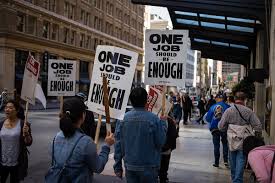
Labor unions have played a significant role in shaping labor rights and working conditions across the globe. This article delves into the history, functions, types, and contemporary issues facing labor unions today.
What Are Labor Unions?
Labor unions are organized groups of workers who come together to collectively bargain for better wages, working conditions, benefits, and rights in the workplace. By pooling their resources and efforts, union members aim to amplify their voices against employers and influence labor policies.
Historical Background of Labor Unions
Labor unions emerged during the Industrial Revolution in the 18th and 19th centuries as workers sought to combat poor working conditions, long hours, and low pay. The rise of industrialization and the exploitation of labor prompted workers to unite for collective action.
Early Formations: The first labor unions were formed in the United States and Europe, primarily by skilled tradesmen. These early unions aimed to protect their members’ interests and improve working conditions. Key Milestones: Significant events, such as the Haymarket Riot of 1886 and the Pullman Strike of 1894, highlighted the struggles between labor and management and the need for organized labor representation.
Functions of Labor Unions
Labor unions serve various essential functions, including:Collective Bargaining: Unions negotiate contracts with employers on behalf of their members. These contracts often cover wages, benefits, work hours, safety standards, and job security.
Advocacy: Unions advocate for workers’ rights at the local, state, and federal levels, pushing for legislation that protects labor rights and improves working conditions.
Support and Resources: Unions provide support to their members, including legal assistance, job training, and educational programs. They also create a sense of community among workers.
Conflict Resolution: Unions help resolve disputes between workers and management, often through grievance procedures and arbitration.
Types of Labor Unions
Labor unions can be categorized into several types based on their structure and focus: Craft Unions: These unions represent skilled workers in specific trades, such as electricians or carpenters. Craft unions focus on the interests of workers within a particular trade. Industrial Unions: Industrial unions represent all workers within a specific industry, regardless of their job functions. For example, the United Auto Workers (UAW) represents workers in the automobile industry. Public Sector Unions: These unions represent employees in government and public services, including teachers, police officers, and firefighters. They advocate for public employees’ rights and benefits. General Unions: General unions can include workers from various industries and trades, providing a broader representation for those not covered by other unions.
Contemporary Issues Facing Labor Unions
Labor unions today face numerous challenges that impact their effectiveness and membership:Declining Membership: In many regions, union membership has declined due to various factors, including changes in the economy, labor laws, and the rise of gig and freelance work. Anti-Union Sentiments: There is often significant opposition to unionization from some employers and political groups. This resistance can lead to challenges in organizing and maintaining union membership.Legislative Changes: Changes in labor laws and policies can significantly affect unions’ bargaining power and ability to represent workers. For instance, right-to-work laws can weaken unions by allowing workers to opt out of union dues
.Globalization: The globalization of labor markets can undermine domestic labor unions by creating competition with lower-wage workers in other countries, leading to job outsourcing and reduced bargaining power.
The Future of Labor Unions
Despite the challenges, labor unions continue to adapt and evolve in response to the changing labor landscape. They are increasingly focusing on: Innovative Organizing Strategies: Unions are exploring new organizing tactics to reach workers in non-traditional employment sectors, including the gig economy. Advocacy for Social Justice: Many unions are aligning their goals with broader social justice movements, advocating for issues such as racial equity, gender equality, and climate justice, which resonate with younger workers. Collaboration and Alliances: Unions are forming alliances with other organizations, such as community groups and civil rights organizations, to strengthen their advocacy efforts and increase their influence.
Labor unions have been a critical force in advocating for workers’ rights and improving working conditions throughout history. While they face several contemporary challenges, their ability to adapt and evolve will be essential in continuing to represent the interests of workers in an ever-changing economy. By understanding the functions and importance of labor unions, we can appreciate their role in promoting fair labor practices and enhancing workers’ lives.
Subscribe to Follow Global Trends for daily global news.
Find Out How To Make Money As A Full Time Writer/Blogger Guide.
To Advertise, Advertise Your Affiliate Links on FollowGlobalTrends.com for Just $1 Per Link Per Month!
Related Articles
Written By: Enyoghasi Ngozi pricillia
,

